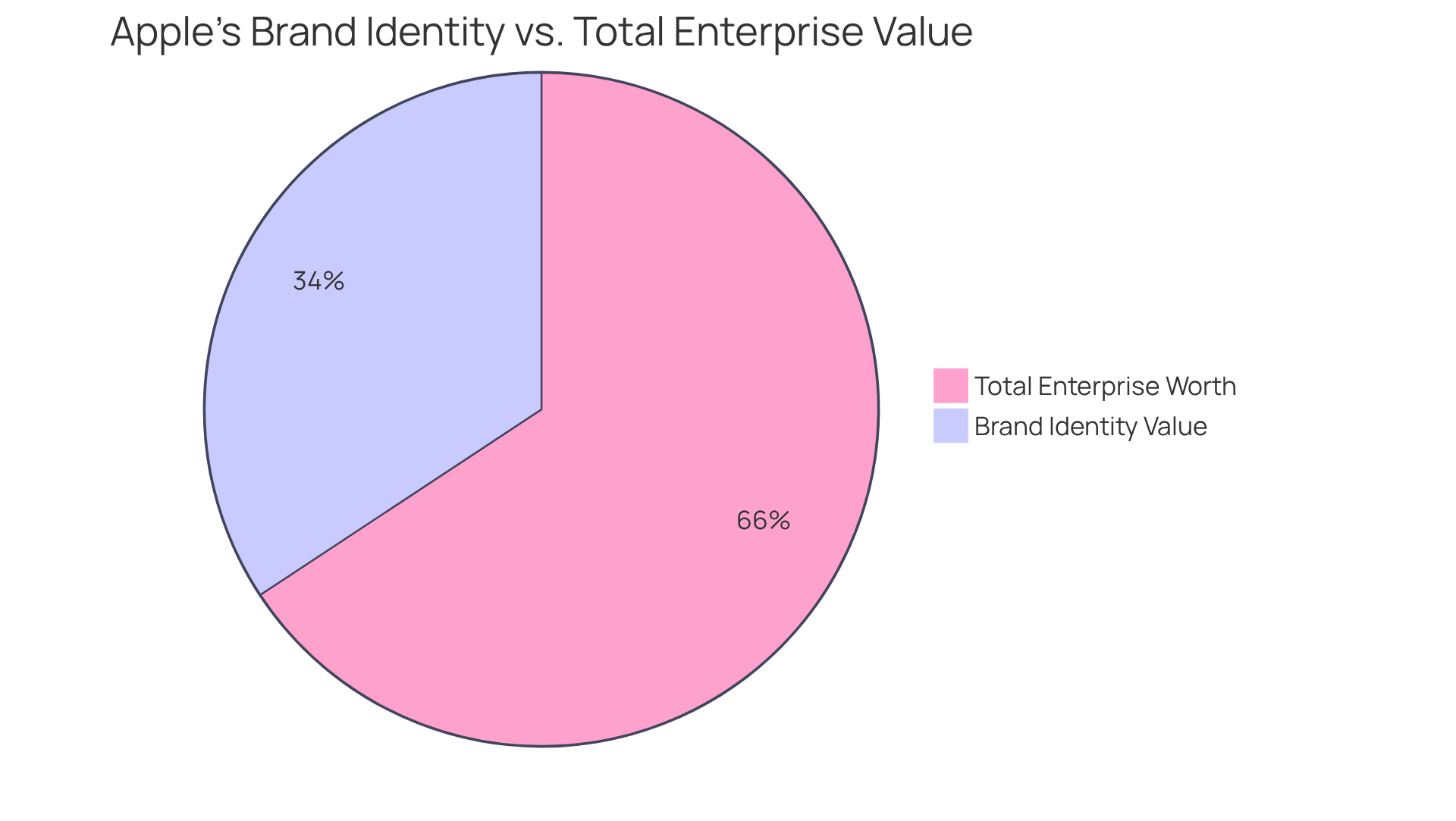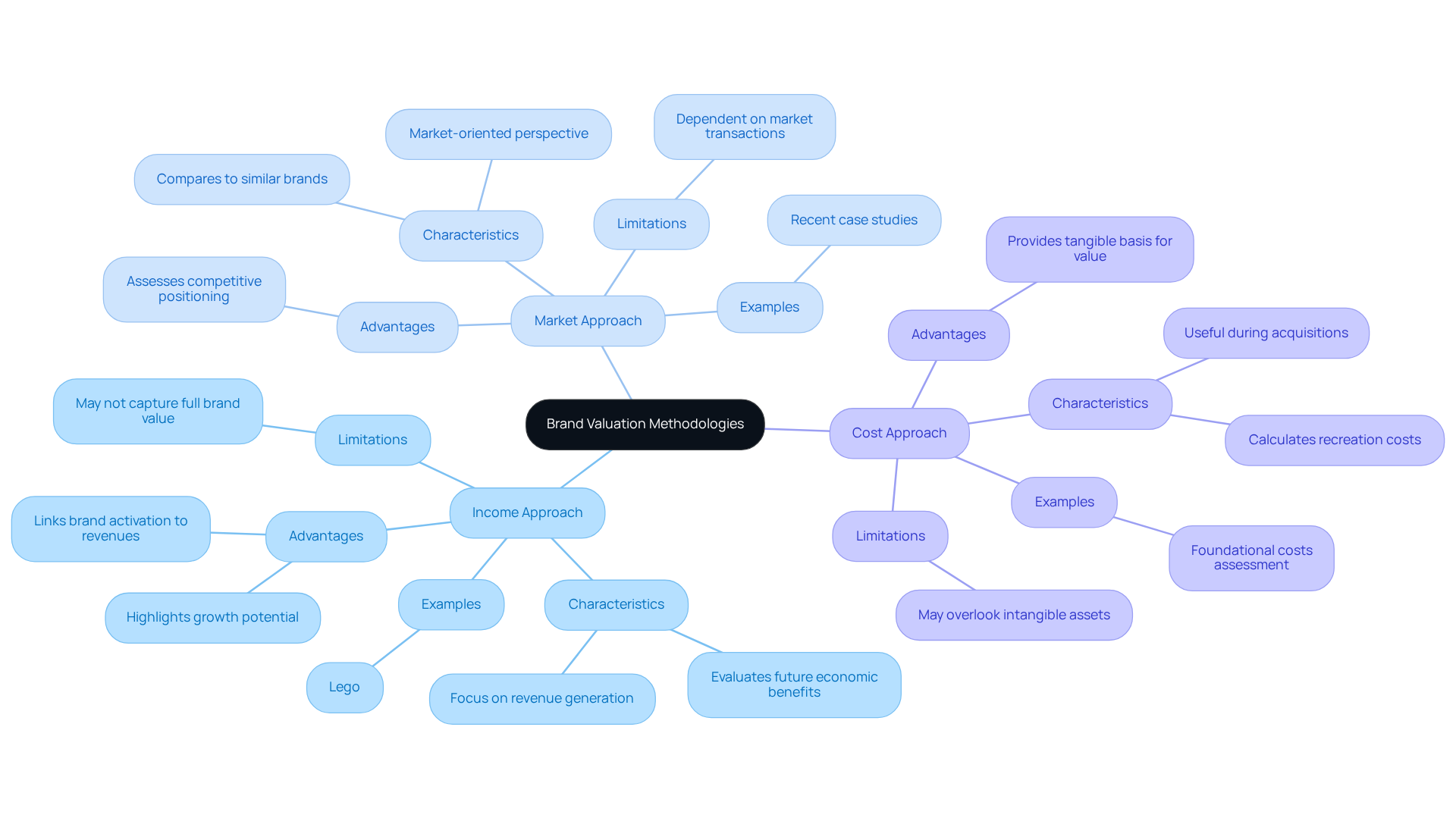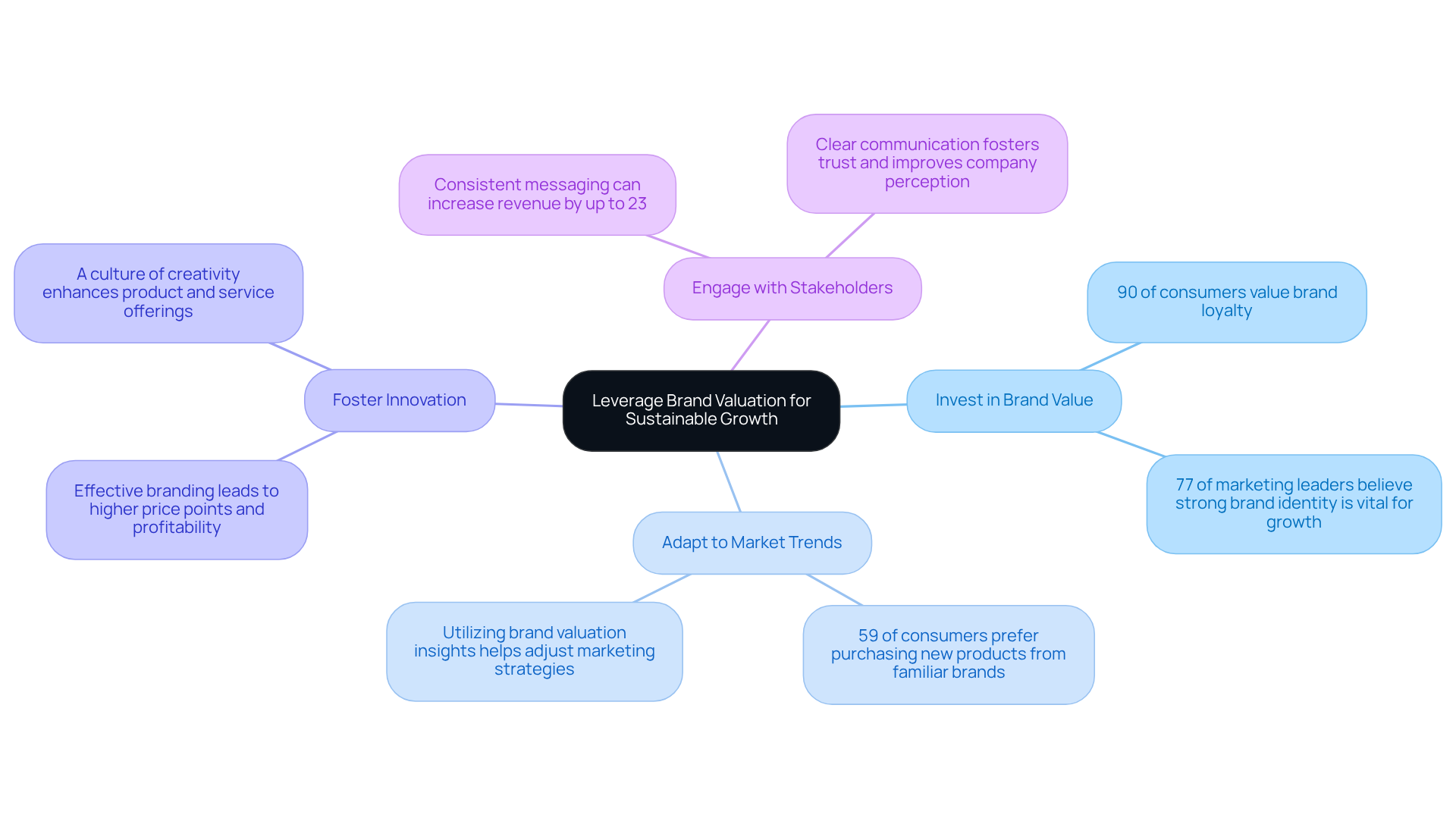Overview
In today's competitive landscape, many businesses face the challenge of effectively valuing their brand. This critical aspect can often feel overwhelming, leaving companies unsure of how to leverage their brand's potential. However, understanding and applying brand valuation methodologies can significantly enhance a company's market position, foster customer loyalty, and ultimately drive sustainable growth.
For instance, consider how Apple's impressive brand equity has played a pivotal role in its overall value and market success. By embracing brand valuation, businesses can not only navigate these complexities but also unlock new opportunities for strategic growth and innovation. Together, we can explore these methodologies and support your journey towards a thriving brand.
Introduction
Understanding the true value of a brand goes beyond mere numbers; it serves as a foundational element that can profoundly impact a company's journey. As businesses face increasingly competitive landscapes, it becomes crucial to recognize the significance of brand valuation for strategic growth and innovation. Yet, many organizations find themselves struggling with the complexities of accurately assessing their brand's worth and effectively leveraging that knowledge. This can be overwhelming, leaving founders to wonder: how can companies transform brand valuation from a daunting task into a powerful tool for sustainable success? Together, we can explore ways to navigate this challenge, turning uncertainty into opportunity.
Define Brand Valuation and Its Importance
The of a trademark can often feel daunting, yet it plays a crucial role in understanding the economic worth of both tangible and intangible assets. Many companies struggle to recognize how this assessment impacts their overall organizational worth. A strong not only fosters but can also lead to increased sales and a competitive edge in the market.
For example, consider Apple's remarkable journey:
- Its company value reached $574.5 billion in 2025.
- A vital component of its overall enterprise worth of $2.3 trillion, with $1.2 trillion directly linked to its brand identity.
- This strong identity empowers Apple to command premium prices and maintain a quality ratio of 4.3, illustrating that loyal customers outnumber non-loyal ones by more than four times.
Similarly, Coca-Cola's enduring market presence has enabled it to build , fostering loyalty that translates into steady sales growth. Consistent marketing efforts can enhance income by as much as 10-20%, highlighting the in a company's identity.
By understanding product assessment, companies gain invaluable insights, equipping them to make strategic decisions regarding investments, marketing strategies, and product management. This ultimately paves the way for , nurturing a brighter future for their endeavors.

Explore Brand Valuation Methodologies
methodologies can feel overwhelming, particularly when navigating the complexities of determining a brand's worth. It's important to recognize that , which can impact your journey as a .
- Income Approach: This method evaluates the current worth of future economic benefits tied to your brand. It’s particularly beneficial for brands focused on . For instance, companies like Lego use this approach to understand the full impact of consumer advocacy and social influence on their reputation. As Mike Moynihan highlights, linking activation to purchase activity and revenues is a valid valuation strategy, underscoring its importance in showcasing growth potential.
- Market Approach: By comparing your brand to similar ones that have recently been sold, this method provides a market-oriented perspective on value. It helps established companies assess their competitive positioning. Recent case studies reveal how firms analyze transactions to gauge their worth. Notably, the from $11 trillion in 2020 to over $13 trillion in 2024, illustrating the relevance of this strategy in today’s rapidly evolving market.
- Cost Approach: This method calculates the costs necessary to recreate your trademark, providing a tangible foundation for understanding equity. It’s commonly utilized during acquisitions, offering insights into the fundamental expenses tied to establishing a business. , as it reflects both tangible and intangible assets that influence your financial standing.
Each methodology has its strengths and weaknesses regarding brand valuation. The income method is particularly favorable for eager to highlight their growth potential, while the market method serves established companies striving to comprehend their market position. Moreover, grasping the distinction between brand equity and brand valuation is vital for navigating the complexities of evaluation in our digital age. Current trends indicate a shift toward more dynamic assessment techniques that address the unique challenges faced by . It’s essential for companies to stay informed and adaptable as they move forward in this landscape.

Apply Brand Valuation in Strategic Planning
Integrating into can seem daunting for many founders of tech startups. It's essential to understand the present worth of your company, as this serves as a crucial reference point for future evaluations and strategic adjustments. By establishing a baseline through recognized methodologies, you can gain clarity on where you currently stand.
Setting clear goals is the next step. Think about what growth means for you—perhaps it's increasing market share or enhancing client loyalty. For example, a tech startup might aim to boost its reputation by 20% within a year by improving its and . As Manisha Saini, a Data-Driven Marketing Expert, wisely notes, " fosters emotional connections, leading to ."
Monitoring your progress is vital. Regular evaluations of your company's worth allow you to track enhancements and adjust your strategies accordingly. Key performance indicators (KPIs) like Net Promoter Score (NPS) and Customer Lifetime Value (CLV) are essential tools for measuring success and guiding your decisions. In 2023, the total worth of the world’s 100 most valuable trademarks reached 6.9 trillion U.S. dollars, underscoring the in today’s market.
Aligning your marketing efforts with your goals for brand valuation is crucial. Ensure that your marketing strategies are designed to enhance your brand valuation, focusing on client engagement and how your company is perceived. This alignment fosters with customers, leading to long-term loyalty. For instance, Nvidia experienced a remarkable in 2024, showcasing the impact of effective marketing strategies.
By following these steps, tech startups can seamlessly incorporate value assessment into their strategic planning. It’s not just about setting ambitious growth objectives; it’s about making them measurable and achievable. Real-life examples from thriving tech startups that have embraced can further illustrate the effectiveness of these steps. Remember, you are not alone on this journey, and there are proven paths to success that can guide you.

Leverage Brand Valuation for Sustainable Growth
To support sustainable growth through , businesses face several challenges that require thoughtful solutions:
- Invest in Brand Value: Many companies struggle with allocating the right resources to . This investment is crucial as studies indicate that 90% of consumers consider loyalty to a brand essential in their purchasing decisions. By nurturing this loyalty, businesses can foster increased sales and customer retention. Furthermore, 77% of marketing leaders believe that a strong is vital for growth strategies, underscoring the in enhancing overall business performance.
- : Companies often find it difficult to keep pace with shifting consumer preferences. Utilizing brand valuation insights can help identify these changes and adjust brand valuation marketing strategies accordingly. For instance, around 59% of consumers prefer purchasing new products from brands they already know, highlighting the importance of building familiarity and trust within the market.
- : A culture of creativity can be elusive for many organizations, yet it is essential for consistently enhancing products and services. Brands that embrace innovative practices often experience significant returns on investment, as can lead to higher price points and increased profitability.
- : Communicating value to stakeholders—including investors and clients—can be a challenge. However, consistent messaging across all platforms can increase revenue by up to 23%, illustrating the importance of clear communication in improving company perception and fostering trust.
For example, Smoopydoo's commitment to a robust branding strategy resulted in enhanced customer loyalty and market share within just two years. This demonstrates the transformative power of effective marketing. As David Aaker wisely notes, "The impact of brand equity on stock return was shown to be about 70% of the impact of accounting ROI." This highlights the significant financial implications of , reinforcing the importance of nurturing your brand for long-term success.

Conclusion
Understanding brand valuation is crucial for businesses striving for strategic growth and innovation. This process not only reveals the economic worth of a brand but also highlights its profound impact on customer loyalty, market positioning, and overall organizational value. By recognizing the importance of brand identity, companies can harness its power to drive sales and maintain a competitive advantage.
Many businesses face the challenge of effectively valuing their brand, often feeling overwhelmed by the complexities involved. This uncertainty can lead to missed opportunities and hindered growth. Throughout the article, we explored various methodologies for brand valuation, including the income, market, and cost approaches. Each method offers unique insights that can guide both startups and established companies in assessing their market position and potential for growth.
Moreover, the importance of integrating brand valuation into strategic planning was emphasized. Setting measurable goals and monitoring progress is essential for achieving sustainable growth. It’s about more than just immediate financial gains; it’s about fostering long-term relationships with customers and adapting to market trends.
By investing in brand equity and maintaining clear communication with stakeholders, businesses can create a resilient brand that thrives in a competitive landscape. Embracing these practices will not only enhance brand loyalty but also pave the way for innovative growth strategies that ensure lasting success. Together, let’s nurture our brands and build a brighter future, fostering connections that will support our journeys in this ever-evolving marketplace.
Frequently Asked Questions
What is brand valuation?
Brand valuation is the process of assessing the economic worth of a trademark, encompassing both tangible and intangible assets.
Why is brand valuation important for companies?
Brand valuation is important as it helps companies understand their overall organizational worth, fosters client loyalty, increases sales, and provides a competitive edge in the market.
How does a strong brand identity impact a company's value?
A strong brand identity enables companies to command premium prices and fosters customer loyalty, which can significantly contribute to their overall enterprise value.
Can you provide an example of a company with a strong brand identity?
Apple is an example, with its brand identity contributing $1.2 trillion to its overall enterprise worth of $2.3 trillion as of 2025.
What role does marketing play in brand valuation?
Consistent marketing efforts can enhance income by 10-20%, highlighting the importance of branding in driving sales growth and customer relationships.
How does understanding product assessment benefit companies?
Understanding product assessment provides companies with insights that aid in making strategic decisions regarding investments, marketing strategies, and product management, leading to sustainable growth and innovation.




